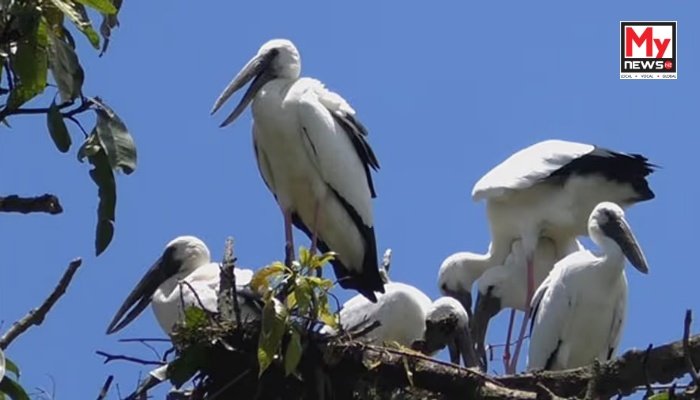Na-mati Village: A Haven for Asian Openbill Storks
Sivasagar, Assam: The tranquil village of Na-mati in Assam’s Sivasagar district is once again abuzz with the familiar sight and sound of thousands of Asian Openbill Storks, signaling the arrival of the monsoon. Nestled near the Dikhow River, this picturesque locale transforms into a bustling avian sanctuary every June and July, drawing in nature enthusiasts keen to witness this annual spectacle. For over two and a half decades, the tall trees of Na-mati have served as a cherished nesting ground for these magnificent birds, a tradition safeguarded by the unwavering dedication of the local villagers.
The community’s commitment to conservation is truly exemplary. In a remarkable display of coexistence, the villagers conscientiously avoid bursting firecrackers during Diwali, ensuring that the storks are undisturbed. Their vigilance extends to actively guarding against poachers and miscreants, guaranteeing a safe haven for their winged guests. These community-led efforts have not only fostered a unique bond between humans and wildlife but have also established Na-mati as a shining model of harmonious living.
Beyond their aesthetic appeal, the storks play a vital role in maintaining the ecological balance and biodiversity of the region. They are natural pest controllers, diligently helping to manage the population of aquatic snails and insects, thus contributing significantly to the health of the local ecosystem. Firuj Hussain, a passionate nature lover, shed light on the intriguing behaviour of these birds, stating, “Openbill was a common bird, although was not seen by people as frequently these days. They are often found in suburban areas, where large groups, sometimes 50 to 60 birds, used to build their nests on a single tree.” He further elaborated on their fascinating colony-based nesting patterns, explaining, “Before settling, a specific group of birds first inspects the area. Once satisfied, the leader calls the rest of the flock, and then the entire group arrives to begin nesting. Although the Openbill is not a migratory bird, its colony behaviour and nesting patterns are quite fascinating.”
Hussain also highlighted another intriguing aspect: the white droppings, rich in phosphorus, scattered around their nesting trees. These droppings act as a natural fertiliser, greatly benefiting the paddy and other crops commonly cultivated in the region. The storks’ uncanny ability to select nesting areas with precise temperature ranges is also noteworthy, as temperature fluctuations are critical for successful hatching. While locals have observed their return for the past 24 years, it is believed that these birds have been frequenting these nesting grounds for centuries.
The annual arrival of the storks has also given rise to a burgeoning eco-tourism trend, with people from neighbouring towns and districts flocking to Na-mati during the nesting season. Recognizing the importance of this natural heritage, local schools and social organisations are actively engaged in spreading awareness and educating the younger generation about the significance of bird conservation. Today, Na-mati stands as a powerful testament to grassroots conservation, where community effort, environmental awareness, and natural beauty converge. The daily chorus of the storks at dawn is more than just a sound; it’s a poignant reminder of the enduring harmony that can exist between nature and humanity.
Read More: Assam: Massive Landslide Claims One Life, Injures Five in Dima Hasao

